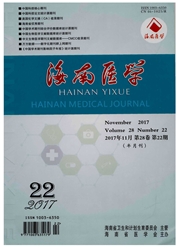

 中文摘要:
中文摘要:
目的观察乌司他丁对急性呼吸窘迫综合征(ARDS)患者氧合指数和病死率的影响。方法将82例入住ICU的ARDS患者随机分成乌司他丁治疗组(观察组)和对照组。对照组采用常规综合治疗和机械通气治疗,观察组在对照组治疗的基础上加用乌司他丁治疗,共7d。观察两组患者治疗前后呼吸频率、氧合指数(PaO2/FiO2)和PaCO2的变化,记录两组患者28d病死率。结果两组患者入ICU时年龄、呼吸频率(次/min)、PaO2/FiO2以及PaCO2(mmHg,1mmHg=0.133kpa)比较差异均无统计学意义(P〉0.05)。治疗7d后观察组呼吸频率明显比对照组慢[(19.8±6.2)vs(27.5±5.3)],差异有统计学意义(P〈0.01);观察组PaO2/FiO2明显比对照组高[(352.1±38.8)vs(291.2±31.6)],差异有统计学意义(P〈0.01);观察组PaCO2与对照组比较差异有统计学意义(P〈0.01),但两组患者PaCO2值均在正常范围内;观察组28d病死率虽比对照组低(23.8%vs30%),但差异无统计学意义(P〉0.05)。结论乌司他丁能提高氧合指数,改善呼吸功能,对ARDS患者有较好的治疗作用。
 英文摘要:
英文摘要:
Objective To study the effects of ulinastatin on oxygenation index and mortality in patients with acute respiratory distress syndrome(ARDS).Methods 82 patients with ARDS were divided into the study group and the control group.The patients in the control group were treated by regular treatment and mechanical ventilation,and while those in the study group were treated additionally by ulinastatin(2.0×106 u,intravenously guttae,every 12 hours for 7 days).The effect of therapy in the two group was evaluated by assessing the respiratory rate,oxygenation index(PaO2/FiO2),PaCO2 and mortality of 28 days.Results There were no differences in age,respiratory rate,oxygenation index(PaO2/FiO2) and PaCO2between the two groups before treatment(P〈0.05).Seven days after treatment,the respiratory rate in the study group(19.8±6.2) was significantly lower than it in the control group(27.5±5.3),P〈0.01.The oxygenation index was significantly higher,(352.1±38.8) and(291.2±31.6) respectively,P〈0.01.The levels of PaCO2 was significantly higher(P〈0.01),but were all within the normal range.The mortality of 28 days was lower,23.8% and 30.0% respectively,with no statistically significant differences between the two groups(P〈0.05),Conclusion Treatment with ulinastatin can improve oxygenation index and pulmonary function in patients with ARDS.
 同期刊论文项目
同期刊论文项目
 同项目期刊论文
同项目期刊论文
 期刊信息
期刊信息
